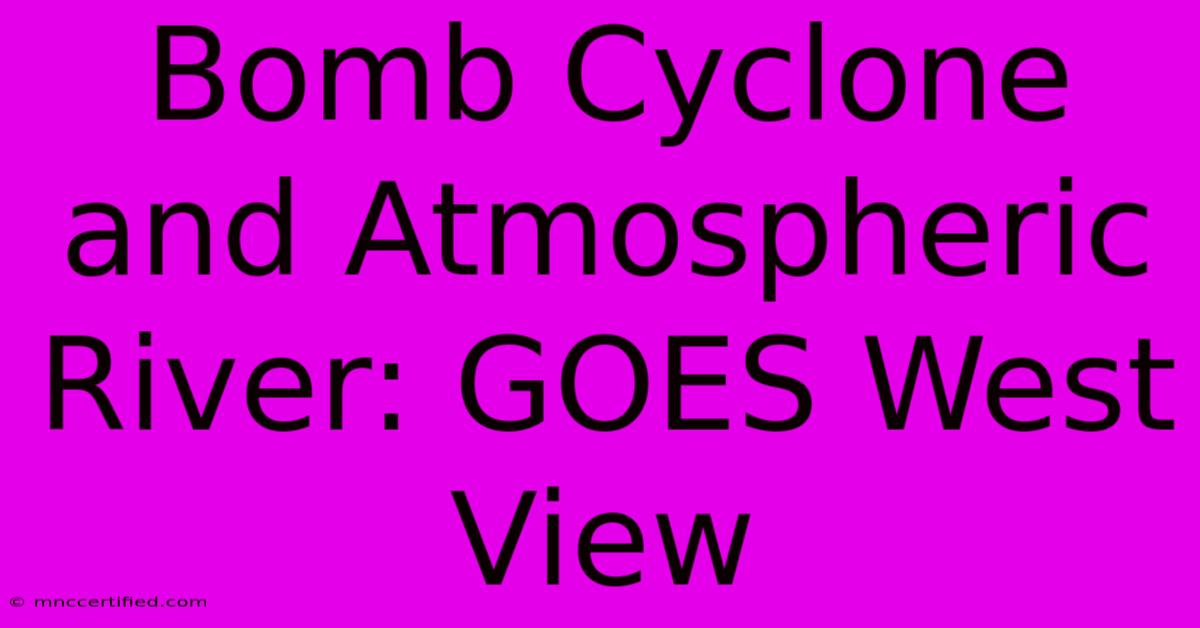Bomb Cyclone And Atmospheric River: GOES West View

Table of Contents
Bomb Cyclone and Atmospheric River: A GOES West View
The Pacific Northwest and beyond often find themselves in the crosshairs of powerful weather systems, two of the most dramatic being bomb cyclones and atmospheric rivers. Understanding these phenomena, especially how they appear from a satellite perspective like the GOES-West imagery, is crucial for weather forecasting and public safety. This article delves into the characteristics of bomb cyclones and atmospheric rivers, focusing on their visual representation in GOES-West satellite data.
Understanding Bomb Cyclones
A bomb cyclone, also known as a bombogenesis, is an extratropical cyclone that intensifies rapidly. This rapid intensification is defined by a drop in central pressure of at least 24 millibars in 24 hours. These storms are characterized by:
- Strong winds: The rapid pressure drop fuels incredibly strong winds, often leading to significant coastal flooding and damage.
- Heavy precipitation: Bomb cyclones frequently bring heavy snowfall, rain, or a mix of both, depending on the temperature profile. This precipitation can cause widespread flooding, landslides, and power outages.
- Rapid development: Their quick intensification makes forecasting challenging, increasing the risk associated with these events.
GOES-West imagery provides a crucial vantage point for observing bomb cyclone development. The satellite's infrared and visible channels can track the cyclone's formation, showing the swirling cloud patterns and the intensity of the storm system. The rapid expansion of the cloud cover, as captured by GOES-West, is a key indicator of bombogenesis.
Atmospheric Rivers: The Water Vapor Highway
Atmospheric rivers (ARs) are long, narrow bands of concentrated water vapor transport in the atmosphere. Think of them as rivers in the sky, carrying enormous amounts of water vapor from the tropics and subtropics towards higher latitudes. Key characteristics include:
- High water vapor content: ARs contain vast amounts of water vapor, capable of releasing significant precipitation upon landfall.
- Length and width: These "rivers" can stretch for thousands of kilometers and be hundreds of kilometers wide.
- Impact on precipitation: When an AR makes landfall, it can release immense amounts of precipitation, leading to flooding, landslides, and other hazards.
GOES-West is instrumental in tracking atmospheric rivers. Its water vapor imagery vividly displays the plumes of moisture being transported across the ocean. By monitoring the intensity and trajectory of these plumes, meteorologists can better predict the potential for heavy precipitation and flooding. The integration of GOES-West data with other meteorological models improves the accuracy of AR forecasts.
GOES-West: The Key Player in Observation
The Geostationary Operational Environmental Satellite-West (GOES-West) plays a critical role in observing both bomb cyclones and atmospheric rivers. Its geostationary orbit allows for continuous monitoring of these systems, providing crucial data for:
- Real-time tracking: GOES-West provides frequent updates on the location, intensity, and movement of both bomb cyclones and ARs.
- Predictive modeling: The data collected by GOES-West is integrated into weather prediction models, improving forecast accuracy.
- Early warning systems: By observing the development of these systems, GOES-West contributes to early warning systems, allowing for timely warnings and evacuations.
Connecting the Dots: Bomb Cyclones and Atmospheric Rivers
While distinct phenomena, bomb cyclones and atmospheric rivers can interact. An atmospheric river can provide the necessary moisture for a developing cyclone, fueling its rapid intensification and increasing the potential for extreme weather events. GOES-West imagery allows meteorologists to observe these interactions, enhancing the understanding of these complex weather systems.
Conclusion: The Importance of Satellite Monitoring
The combination of bomb cyclones and atmospheric rivers can create exceptionally dangerous weather conditions. The GOES-West satellite provides invaluable data for monitoring and predicting these events, leading to improved forecasting and ultimately helping to save lives and mitigate damage. Understanding the visuals provided by GOES-West, like the rapid intensification visible in infrared imagery during bombogenesis or the pronounced water vapor plumes indicative of atmospheric rivers, is crucial for those in regions prone to these powerful weather systems. Continued advancements in satellite technology will further refine our ability to predict and prepare for these impactful weather phenomena.

Thank you for visiting our website wich cover about Bomb Cyclone And Atmospheric River: GOES West View. We hope the information provided has been useful to you. Feel free to contact us if you have any questions or need further assistance. See you next time and dont miss to bookmark.
Featured Posts
-
Nvidia Nvda Stock Jump Tomorrow
Nov 21, 2024
-
Post Malone Coachella 2025 Lineup Revealed
Nov 21, 2024
-
Unexpected Today Show Moment
Nov 21, 2024
-
How Much Is 100000 Bitcoin Worth
Nov 21, 2024
-
Alfa Romeo Giulia Insurance Cost
Nov 21, 2024